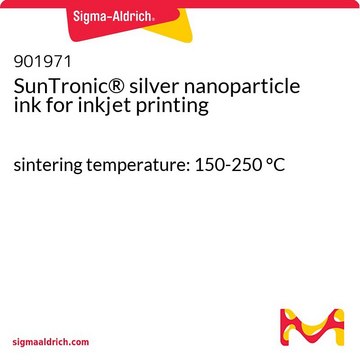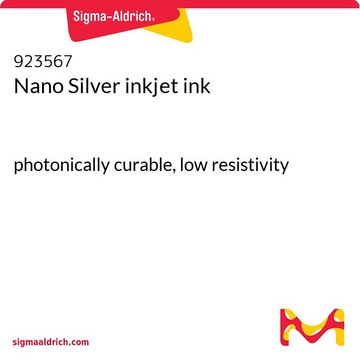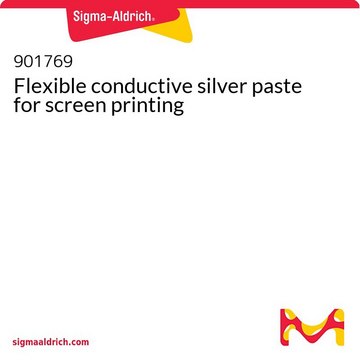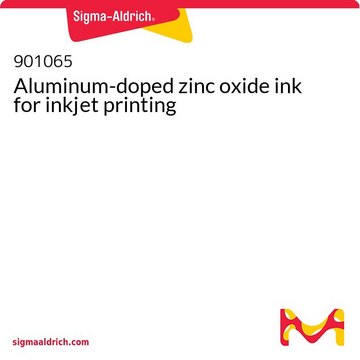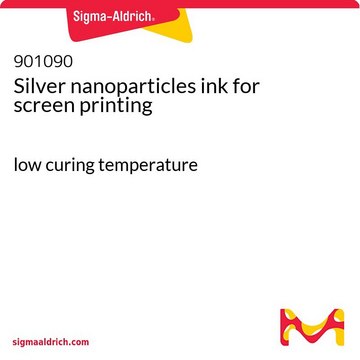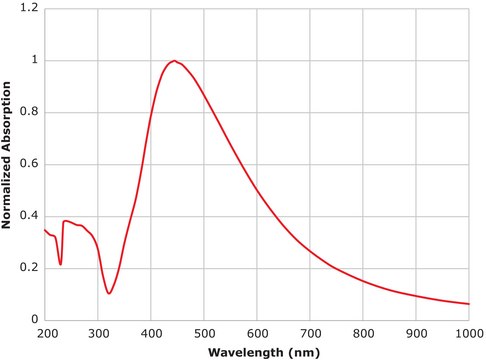907022
Conductive nanosilver ink for inkjet printing
Synonym(s):
Ag ink, Conductive ink, Prelect SPS 201
About This Item
Recommended Products
description
Silver content:18-20%W/W
form
liquid
color
dark gray
mean particle size
85-105 nm
surface tension
36.0-44.0 mN/m
viscosity
12.5-18.5 mPa.s (25 °C, shear rate 1000 s-1)
density
1.3 g/mL
storage temp.
2-8°C
General description
Key Benefits
- Low volume resistivity
- Compatible with several sintering methods
- Good adhesion on coated and synthetic papers, treated and untreated PET
- Support for industrial print heads
- High stability and easy handling
Typical Properties of Printed and Sintered Product
Single pass printed with KM1024i LHE on PowerCoat® HD1 and sintered with NIR lamp.
- Resistivity <3 mW//25μm
- Dry Film Thickness 1-2 μm
- Printing resolution 150 μm lines & gaps
- Adhesion 0-1 (ISO 2409 crosshatch test, no material removal)
Application
Caution
- For prolonged shelf life, store between 0 and 4°C. Under typical jetting conditions, the ink will remain stable for one week.
- Tested print heads are KM1024i LHE, Q-class Sapphire, DMC11610 (disposable cartridge)
- Print head temperature between 25 and 35 ºC
- Substrate temperature between 25 and 60 ºC
- Sintering in ventilated box oven 150 ºC for 30 minutes. Higher sintering temperatures result in higher film conductivities and lower dwell times. Best results on paper have been obtained with NIR lamp
- To avoid contamination from other inks before loading the print head with silver ink, it is recommended to flush with ethanol first, then flushing with the associated cleaning solution SI-JCS1, and then load the silver ink.
To clean the print head after use, proceed in reverse order.
The above printing and sintering conditions are guidelines. Conditions may vary based on customers′ experience and their application requirements, as well as customer printing and drying equipment.
Legal Information
Signal Word
Danger
Hazard Statements
Precautionary Statements
Hazard Classifications
Aquatic Acute 1 - Aquatic Chronic 1 - Eye Dam. 1 - Repr. 1B - STOT SE 3
Target Organs
Respiratory system
Storage Class Code
6.1C - Combustible acute toxic Cat.3 / toxic compounds or compounds which causing chronic effects
WGK
WGK 3
Flash Point(F)
>230.0 °F
Flash Point(C)
> 110 °C
Choose from one of the most recent versions:
Certificates of Analysis (COA)
Don't see the Right Version?
If you require a particular version, you can look up a specific certificate by the Lot or Batch number.
Already Own This Product?
Find documentation for the products that you have recently purchased in the Document Library.
Articles
Small molecular weight organic semiconductors are promising for flexible transistor applications in next-gen soft electronics.
Professors Tokito and Takeda share design principles and optimization protocols for organic electronic devices, focusing on flexibility and low cost.
Our team of scientists has experience in all areas of research including Life Science, Material Science, Chemical Synthesis, Chromatography, Analytical and many others.
Contact Technical Service
